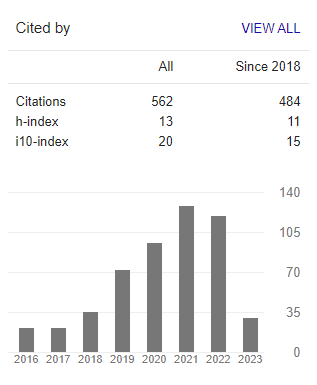Memetics and Filmmaker Habitus in the Indonesian Film Industry
Abstract
Typically, film companies produce films that are ready for distribution to cinemas. Film work is the result of collective work. Starting from the involvement of producers, directors, screenwriters, cameramen, and editors, to artistic stylists (production team) through pre-production, production, and post-production processes. Although it is not uncommon to find that film works are not single and sterile works of replication or imitation, which refer to patterns and systems - including film production management and its entities - that have been previously established as a cultural industry. For this reason, the author uses the concept of Meme initiated by Richard Dawkins and synthesized with Pierre Bourdieu's sociological concept, namely: (Habitus x Capital) + Domain = Practice, as well as the cultural industry. The cause of film workers imitating previous works is the rationale for researching the film industry, especially in Indonesia. This research aims to prove that the phenomenon of memetics and habitus seneas occurs in the film industry in various countries, both developed and developing countries. To achieve this goal, the method applied in this research is the descriptive qualitative method. Data is obtained from documentation in the form of film works, especially the film Gundala, which involves the production team. The results of the analysis show that there are memetics and habitus of filmmakers in the film industry. This can be found in a number of production houses that carry out the practice, including Jagad BumiLangit, Falcon Pictures, and Screenplay. Almost every film work is imitative. The implications of this imitation can also be found in several cases of imitation of film works; in Hong Kong, Taiwan, Thailand, India, Japan, Europe, and America.
To cite this article (7th APA style):
Hadibroto, J. U. & Nurdiansyah, D. (2023). Memetics and filmmaker habitus in the Indonesian film industry. Journal Communication Spectrum: Capturing New Perspectives in Communication 13(1), 30-41. https://doi.org/10.36782/jcs.v13i1.2385
Keywords
References
Badriati, M. (2005). Dominasi pemilik modal dan resistensi pekerja media: Studi kasus majalah berita mingguan Gatra pada pasca orde baru [Bachelor's thesis]. Universitas Indonesia.
Barker, C. (2005). Cultural studies: Teori dan praktik (Nurhadi, Trans.). Bentang Pustaka. (Original work published 2000)
Bourdieu, P. (2002). Distinction: A social critique of the judgement of taste (R. Nice, Trans.). Harvard University Press. (Original work published 1979)
Brodie, R. (2005). Virus Akal Budi. Kepustakaan Populer Gramedia.
Davies, M. M., & Mosdell, N. (2006). Practical research methods for media and cultural studies: Making people count. Edinburgh University Press.
Eaton, M. M. (2010). Persoalan-persoalan dasar estetika (E. K. Ekosiwi, Trans.). Salemba Humanika. (Original work published 1987)
Giddens, A. (1984). The constitution of society: Outline of the theory of structuration. Polity Press.
Hall, S. (1997). The Work of Representation. In S. Hall (Ed.), Representation: Cultural representations and signifying practices (pp. 13–58). SAGE Publications.
Harker, R., Mahar, C., & Wilkes, C. (Eds.). (2009). (Habitus x modal) + ranah = praktik: Pengantar paling komprehensif kepada pemikiran Pierre Bordieu (P. Maizier, Trans.). Jalasutra. (Original work published 1990)
Heylighen, F., & Chielens, K. (2009). Evolution of Culture, Memetics. In R. A. Meyers (Ed.), Encyclopedia of Complexity and Systems Science (pp. 3205–3220). Springer New York. https://doi.org/10.1007/978-0-387-30440-3_189
Horkheimer, M., & Adorno, T. W. (2002). Dialectic of enlightenment: Philosophical fragments (G. S. Noeri, Ed.; E. Jephcott, Trans.). Stanford University Press. https://doi.org/10.1515/9780804788090 (Original work published 1944)
Hume, D. (1965). Of the standard of taste and other essays (J. W. Lenz, Ed.). Macmillan Publishing. (Original work published 1757)
Ida, R. (2014). Metode penelitian: Studi media dan kajian budaya. Kencana.
Jay, M. (2005). Sejarah mazhab Frankfurt: Imajinasi dialektis dalam perkembangan teori kritis (I. R. Muzir, Trans.). Kreasi Wacana. (Original work published 1973)
Keller, K. L. (2013). Strategic brand management (4th ed.). Pearson Education.
Mahzar, A. (2006). Melacak Mutasi-Mutasi Meme. In A. Adlin (Ed.), Resistensi gaya hidup: Teori dan realitas. Jalasutra.
Nurudin. (2001). Komunikasi propaganda. Remaja Rosdakarya.
Prakosa, G. (2004). Film dan kekuasaan. Yayasan Seni Visual Indonesia.
Salim, A. (2006). Teori dan paradigma penelitian sosial: Buku sumber untuk penelitian kualitatif (2nd ed.). Tiara Wacana.
Strinati, D. (2004). Popular culture: Pengantar menuju teori budaya populer (A. Mukhid, Trans.; 2nd ed.). Bentang. (Original work published 1995)
Thomas, B. (2019, August 22). Brand behaviour vs. brand value. Nalla. https://nalla.co.uk/brand-behaviour-vs-brand-value
Wijaya, B. S. (2015). Midnight culture: Ketika kaum muda urban memperlakukan malam sebagai siang. In Budiawan (Ed.), Media [baru], tubuh, dan ruang publik: Esei-esei kajian budaya dan media (pp. 165–200). Jalasutra.
Wijaya, B. S. (2019). Relasi konsumen dan merek di Indonesia: Disposisi individual dan refleksi sosio-kultural [Doctoral dissertation]. Universitas Gadjah Mada.
Wijayanto, E. (2013). Memetics: Perspektif evolusionis membaca kebudayaan. Kepik.
Refbacks
- There are currently no refbacks.

This work is licensed under a Creative Commons Attribution 3.0 License.
Indexed by:
Archived in:
Listed in:
INTERNATIONAL ASSOCIATION FOR MEDIA AND COMMUNICATION RESEARCH

















